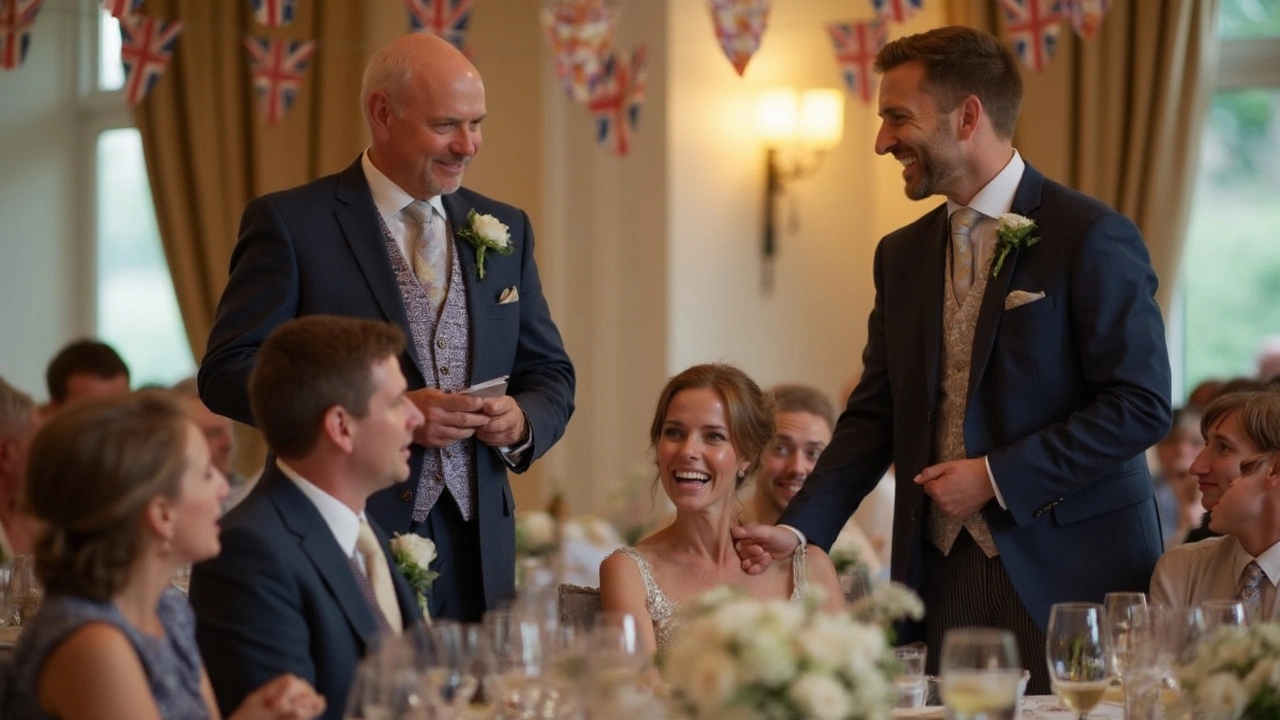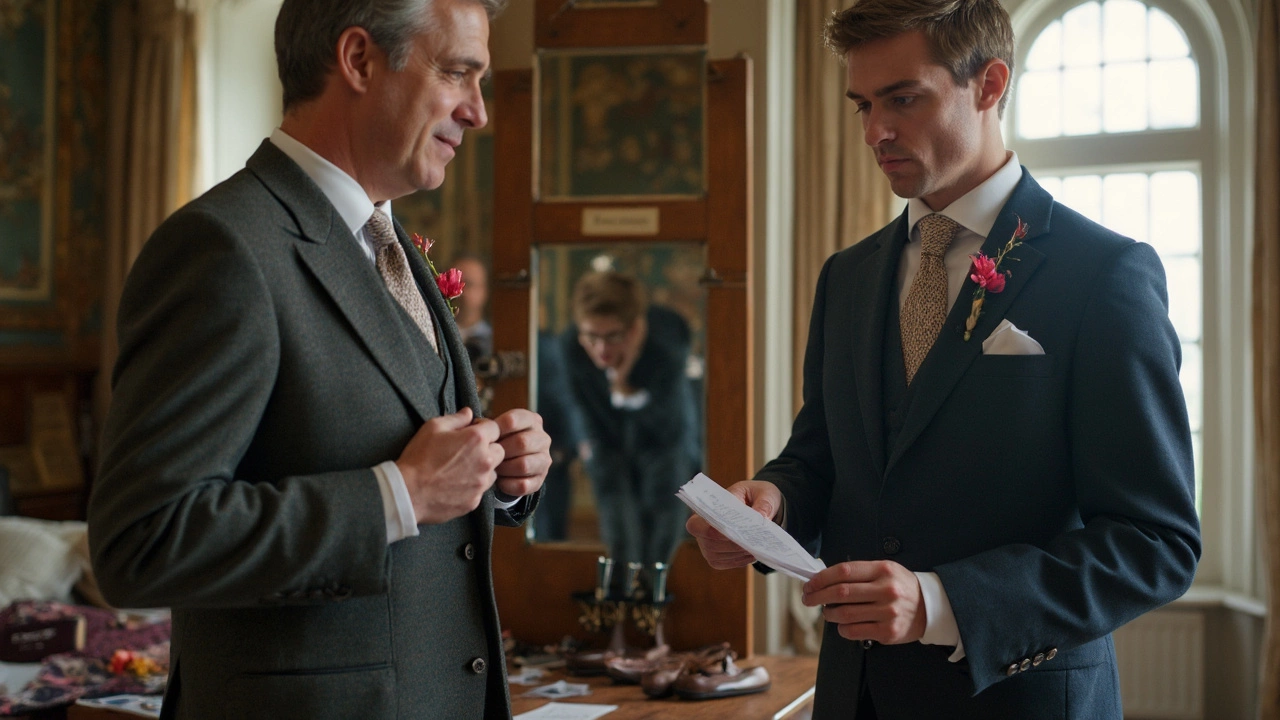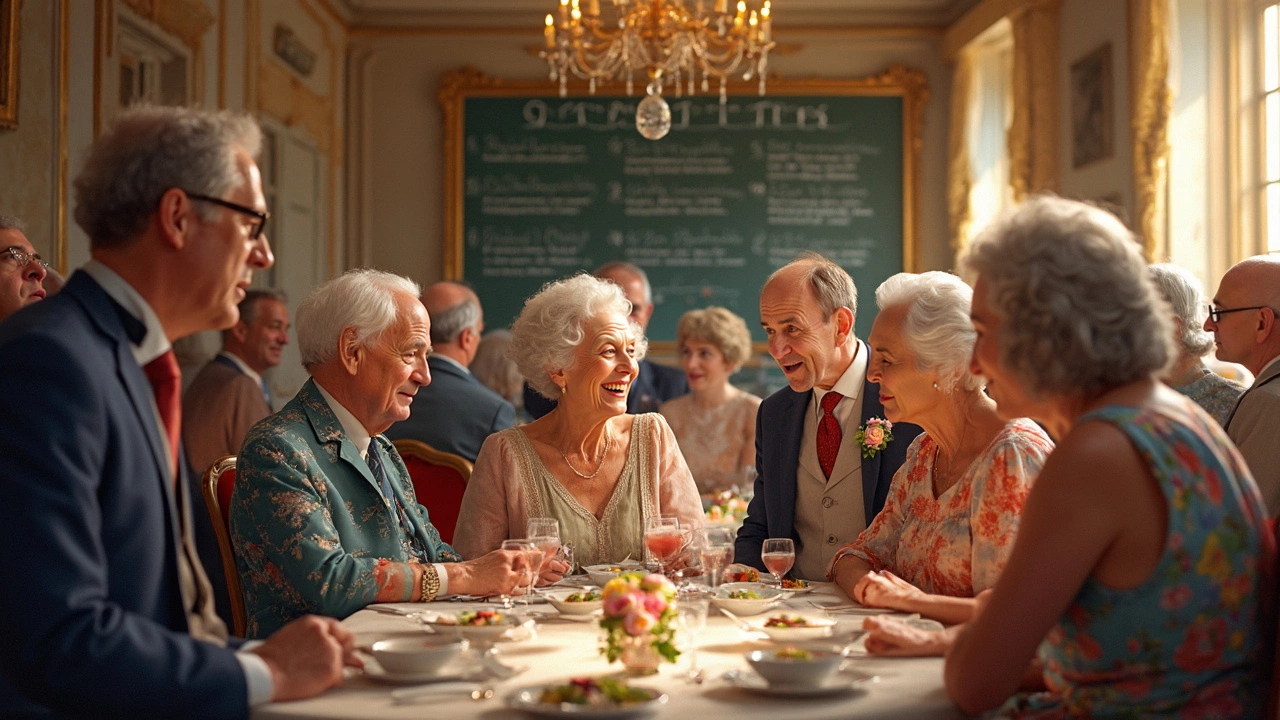Does the Father of the Groom Give a Speech? Groom Suit Style Meets Wedding Traditions
 Apr, 20 2025
Apr, 20 2025
So, does the father of the groom really have to give a speech, or is that just another thing people stress over for no reason? For years, wedding traditions and guest expectations have been changing. Some people stick tightly to old-school rules, while others skip speeches altogether and head straight for the dance floor.
The short answer: the father of the groom isn’t always obligated to speak. In the UK, his speech is pretty common, but in the US, it’s more of a 'nice touch' than a rule. Usually, the big talking roles go to the father of the bride, best man, and maid of honor. But weddings get personal—sometimes both dads want to share a funny or heartfelt moment. It all depends on the couple’s vibe and family style.
- Who Traditionally Gives Speeches at Weddings?
- Is the Father of the Groom Expected to Speak?
- Ideas for the Father of the Groom Speech
- What Should the Father Wear?
- Modern Etiquette and Family Dynamics
Who Traditionally Gives Speeches at Weddings?
At most weddings, there's a usual lineup for speeches—and it actually depends a lot on where you are. In the US, the main speakers are usually:
- Father of the Bride: He's often the first up. People expect him to welcome everyone, share some stories, and get everyone teary-eyed or laughing.
- Best Man: This guy’s speech is famous for funny stories and a toast to the couple.
- Maid of Honor: She usually follows the best man, focusing more on the bride with personal memories.
In the UK, the father of the groom gets his own spotlight way more often. Over there, it’s normal for both dads to speak.
Check out this quick side-by-side to see the differences:
| Country | Usual Speakers |
|---|---|
| US | Father of Bride, Best Man, Maid of Honor |
| UK | Father of Bride, Father of Groom, Groom, Best Man |
That said, nothing is set in stone these days. Some families mix things up and invite anyone who wants to say a few words—or even open it up to the whole room.
The point is, if you’re planning your speeches, it helps to know the standard lineup so everyone’s on the same page and nobody gets left out or surprised. Plus, when folks decide who’s speaking, it makes it easier to figure out the timing and order during the reception.
Is the Father of the Groom Expected to Speak?
Traditions can get confusing—especially with who talks at the reception. The father of the groom speech really depends on which side of the pond you’re on. In the UK, it’s expected after the groom, right after the classic father of the bride speech. But in the US, there’s no hard and fast rule. In most American weddings, the spotlight often falls on the best man, maid of honor, and maybe the couple’s parents if they’re up for it.
According to The Knot's 2024 survey, only about 27% of US weddings included a speech from the groom's father. Compare that to the UK, where nearly 75% of formal weddings count on hearing from "Dad number two." That’s a pretty big difference! Check out this breakdown:
| Country | F.O.G. Speech Rate |
|---|---|
| USA | 27% |
| UK | 75% |
One thing is clear: it’s not about pressure, it’s about preference. Some families aren’t into speeches at all. Others love stacking them up—it’s a way to get everyone involved. Sometimes the groom’s father is asked for a toast, instead of a big speech. If the couple wants both dads talking, they might go for a "joint toast," keeping it short so nobody’s snoring before dinner.
“The father of the groom speech is a growing trend, but it's not a must-do. Your family should feel free to adapt traditions to fit your own celebration.” — Sarah Zlotnick, wedding etiquette expert at Brides
The real answer: there’s no wedding police coming for you if Dad doesn’t get a speech. It’s totally okay to skip it, keep it casual, or hand the mic to someone else. Make it work for your family—they’re who the day is really about.

Ideas for the Father of the Groom Speech
Writing a father of the groom speech can feel like a lot of pressure, but there’s really no need to overthink it. You don’t need to sound like a comedian or deliver some Oscar-worthy monologue. Instead, aim for simple, real, and heartfelt. People remember the genuine stuff way more than fancy jokes or long-winded stories.
A good speech usually sticks to three or four main things. You welcome everyone, say something about your son (the groom), share a warm thought about the bride, and give your best wishes. That’s it! If you want more structure, here's a common order that works well:
- Start by saying thanks: Welcome guests and thank everyone for coming, especially those who traveled far or helped out with the wedding.
- Talk about your son: Share a quick childhood memory, a quirk, or something that makes you proud of him. Keep it light—nobody’s looking for his full life story.
- Mention the bride: Say something positive about your new daughter-in-law. You could talk about the first time you met or what she brings to your son's life.
- Cheers and best wishes: End with a toast to the couple—nothing too long or formal, just a genuine wish for their happiness.
If you’re nervous about talking in front of a crowd, keep it short. The sweet spot for most wedding speeches is about 3-5 minutes. Practice reading your speech out loud a few times—it’ll help you sound natural instead of stiff.
Here’s a tip: skip embarrassing stories or secret family details. What sounds funny at home can turn awkward in a room full of relatives and friends. Also, leave out inside jokes that most people won’t get.
Want your speech to come across even better? Dress the part. According to a survey by The Knot, 78% of fathers who felt comfortable in their groom suits said they were more relaxed during their speech. Confidence starts with feeling good in what you’re wearing.
If you want examples, plenty of websites offer ready-made speech templates—just don’t copy them word-for-word. Personal touches are always better received. Jot down a few notes on a card instead of reading from your phone, so you can keep it relaxed and personal.
What Should the Father Wear?
If you’re the father of the groom, picking your outfit matters almost as much as your speech. It’s all about matching the wedding vibe. Are you heading to a fancy ballroom or chilling in a backyard? The details matter.
The unwritten rule: don’t outshine the couple, but don’t show up looking like you just wandered in. Coordinating with the groom suits is key. If the wedding has a color scheme or a dress code, stick to it. Usually, this means a suit or tuxedo in a color that works with the groom’s look, not an exact copy.
- If the groom’s wearing a sharp navy suit, you can go for charcoal or another dark neutral—not black unless it’s black-tie.
- If it’s a summer wedding and the groomsmen wear light grey or even tan, feel free to match the brightness but go for something one shade darker for a subtle dad vibe.
- For black-tie events, a classic black tuxedo is safest. But double-check the invite, because sometimes dress codes get creative.
Accessories are your secret weapon. A tie or pocket square in the wedding colors ties your look together without trying too hard. If in doubt, ask the couple or the wedding planner for tips. You can also coordinate with the father of the bride, so both dads look like they belong at the same party.
Quick tip: double-check fit early! Tailoring makes a world of difference, especially in photos. Baggy pants and loose jackets look awkward next to those sharp groom suits.
Here’s a quick table with wedding dress code basics for dads:
| Wedding Style | What to Wear |
|---|---|
| Black Tie | Black tuxedo, black bow tie, classic dress shoes |
| Formal/Evening | Dark suit, dress shirt, conservative tie |
| Beach/Casual | Light-colored suit, linen shirt, dressy loafers |
| Rustic/Outdoor | Tweed or earth-tone suit, simple tie, brown shoes |
Bottom line: dress to match the mood (and the photos), but let the groom suits lead. Comfort matters—no one wants to see Dad squirming mid-speech because his collar’s cutting off his air supply.

Modern Etiquette and Family Dynamics
Weddings tend to put a spotlight on family roles, especially when it comes to speeches and clothing. But here’s the thing: there’s no longer a one-size-fits-all rule about the father of the groom speech or what the dad should wear. In reality, modern etiquette is all about what feels natural for your family and what fits your celebration.
Some couples want every parent represented at the mic, while others skip parent speeches entirely to cut down on the length of the reception or ease the pressure. According to The Knot’s 2023 wedding survey, only about 1 in 5 weddings in the US included a speech from the groom’s father. In the UK and Ireland, though, it’s way more common, often following a set order: father of the bride, groom, best man, and sometimes the groom’s dad tossing in a short toast.
If you’re wondering what’s expected, open communication is everything. Some families are all about tradition, while others break every rule. Ask your son and his partner if they want you to say a few words or if they’re keeping things short and sweet. There’s no shame in sticking to your comfort zone or stepping up if you’re excited to share your story.
- If there are divorced or blended families, sometimes both a birth father and stepdad want to pitch in. Usually, the emcee mentions who will speak, so there’s no surprise or awkward shuffle.
- If you’re from a background where a father of the groom speech is rare, but want to do it anyway, it’s not weird at all—wedding customs constantly shift with the times. People love hearing about family memories or inside jokes from another point of view.
Now, let’s talk about attire and expectations. Groom suits have become so much more versatile, and so has dad’s dress code. There’s no law forcing fathers into stiff tuxedos if that’s not the vibe. Matching or coordinating with the groom and groomsmen works best for photos, but these days, comfort and personality count just as much. Just double-check if there’s a set color scheme or formalwear guideline.
Weddings today are a mix of old-school rituals and new family combos, so don’t get hung up on what’s "supposed" to happen. A thoughtful, simple speech or a cool suit that fits your personality can mean a lot. The only real rule? Make sure it’s genuine and supports the couple, whether you’re speaking, dancing, or just enjoying the celebration.